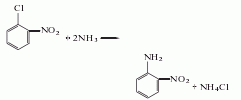
Structural formula
| Business number | 0200 |
|---|---|
| Molecular formula | C6H6N2O2 |
| Molecular weight | 138 |
| label |
1-amino-2-nitrobenzene, 2-nitroaniline, 2-Nitroaniline, 1-Nitro-2-aminobenzene, Aromatic nitrogen-containing compounds and their derivatives |
Numbering system
CAS number:88-74-4
MDL number:MFCD00007687
EINECS number:201-855-4
RTECS number:BY6650000
BRN number:509275
PubChem number:24886436
Physical property data
1. Character: orange-yellow needle-like crystal[1]
2. Melting point (℃): 73~76[2]
3. Boiling point (℃): 284.5[3]
4. Relative density (water=1): 1.44[4]
5. Relative vapor density (air=1): 4.77[5]
6. Saturated vapor pressure (kPa): 0.13 (104 ℃)[6]
7. Heat of combustion (KJ/mol): -3201.1[7]
8. Critical pressure (MPa): 4.42[8]
9. Octanol/water partition coefficient: 1.44~1.83[9]
10. Flash point (℃): 168[10]
11. Ignition temperature (℃): 521[11]
12. Solubility: Slightly soluble in cold water, soluble in hot water and ethanol, easily soluble in ether, acetone and benzene. [12]
Toxicological data
1. Acute toxicity[13]
LD50: 1600mg/kg (rat oral); 20000mg/kg (rabbit transdermal)
2. Irritation No information available
3. Mutagenicity[14] Microbial mutagenicity: Salmonella typhimurium 50μg/dish. DNA repair: Bacillus subtilis 5mg/dish. Micronucleus test: mice take 738 mg/kg orally. Cytogenetic analysis: hamster ovary 10mmol/L.
Ecological data
1. Ecotoxicity[15] LC50: 17mg/L (48h) (medaka)
2. Biodegradability No data yet
3. Non-biodegradability[16] In the air, when the hydroxyl radical concentration is 5.00×105/cm3, the degradation half-life is 1.2d (theoretical).
Molecular structure data
1. Molar refractive index: 37.03
2. Molar volume (cm3/mol): 103.5
3. Isotonic specific volume (90.2K ): 288.5
4. Surface tension (dyne/cm): 60.3
5. Dielectric constant: None available
6. Polarizability ( 10-24cm3): 14.68
7. Single isotope mass: 138.042927 Da
8. Nominal mass: 138 Da
9. Average mass: 138.124 Da
Compute chemical data
1. Hydrophobic parameter calculation reference value (XlogP): None
2. Hydrogen bond donor�Number of bonds: 1
3. Number of hydrogen bond acceptors: 3
4. Number of rotatable chemical bonds: 0
5. Tautomers Number: None
6. Topological molecule polar surface area 71.8
7. Number of heavy atoms: 10
8. Surface charge: 0
9. Complexity: 132
10. Number of isotope atoms: 0
11. Determine the number of atomic stereocenters: 0
12. Uncertain Number of atomic stereocenters: 0
13. Determined number of stereocenters of chemical bonds: 0
14. Uncertain number of stereocenters of chemical bonds: 0
15 .Number of covalent bond units: 1
Properties and stability
1. Stability[17] Stable
2. Incompatible substances [18] Acids, acid chlorides, acid anhydrides, chloroform, strong oxidizing agents, strong reducing agents
3. Conditions to avoid contact[19] Heating
4. Polymerization hazard[20] No polymerization
5. Decomposition products[21] Nitrogen oxides, ammonia
Storage method
Storage Precautions[22] Store in a cool, ventilated warehouse. Keep away from fire and heat sources. The packaging is sealed. They should be stored separately from oxidants, reducing agents, acids, and food chemicals, and avoid mixed storage. Equipped with the appropriate variety and quantity of fire equipment. Suitable materials should be available in the storage area to contain spills.
Synthesis method
Add o-nitrochlorobenzene into an autoclave containing a certain concentration of ammonia water, and perform ammonolysis at 185~190℃ and 4~4.5MPa to generate crude o-nitroaniline, which is then cooled, crystallized and filtered , that is, the finished product is obtained.

Purpose
1. Dye intermediates. It is used to prepare orange-based GR, the color base of ice dye dye, which is widely used in dyeing cotton and linen fabrics. Also used in the preparation of lakes. It is also used as a raw material for the production of the pesticide carbendazim, an anti-ash agent for photography, and an analytical reagent for measuring trace amounts of iodide.
2. Used as a dye intermediate, used in the synthesis of photographic anti-fog agents, and also used in the determination of trace iodides, the production of the pesticide carbendazim, etc. [23]

 微信扫一扫打赏
微信扫一扫打赏

